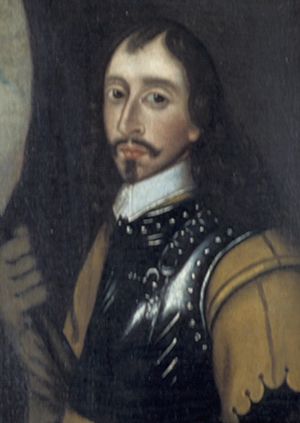Edward Massey facts for kids
Quick facts for kids
Sir
Edward Massey
|
|
|---|---|

Sir Edward Massey
|
|
| Privy Council of Ireland | |
| In office 1661 – 1674 † |
|
| Member of Parliament for Gloucester |
|
| In office April 1660 – May 1674 |
|
| Member of Parliament for Wootton Bassett |
|
| In office June 1646 – December 1648 |
|
| Parliamentarian Governor of Gloucester | |
| In office 1642–1645 |
|
| Personal details | |
| Born | c. 1619 Coddington, Cheshire |
| Died | 1674, age 52-54 Abbeyleix, Ireland |
| Nationality | English |
| Military service | |
| Rank | General |
| Battles/wars | |
Sir Edward Massey (born around 1619, died 1674) was an English soldier and politician. He was also known as Massie. He came from Cheshire, England.
Edward Massey was a member of the House of Commons at different times. He fought for Parliament during the First English Civil War. He became famous for defending the city of Gloucester.
Later, he changed sides and supported King Charles II. He fought for the King during the Anglo-Scottish war (1650–1652). After being badly hurt in the Battle of Worcester in 1651, he was captured. However, he managed to escape and joined the King's court in the Dutch Republic.
During the time when England had no king (called the Interregnum), he worked to bring the King back. He was part of a rebellion in 1659. After the King returned in 1660, Edward Massey was made a knight. He served as a Member of Parliament (MP) for Gloucester until he died. He also became a member of the Privy Council of Ireland in 1661. He spent much of his later life in Abbeyleix, Ireland, where he passed away in 1674.
Contents
Early Life and Military Start
Edward Massey was born in Coddington, Cheshire. He was the fifth son of John Massey and Anne Grosvenor. As a young man, he might have been an apprentice in London.
He then joined the Dutch army. He fought against the Spanish armies in the Spanish Netherlands. In 1639, he was a captain in the army of Charles I of England. This army was fighting against the Scots. When the English Civil War began, he was with the King. But soon after, he joined the Parliament's army.
Fighting for Parliament
Edward Massey became a lieutenant colonel in the Parliament's army. He was made deputy governor of Gloucester. He stayed there for most of the First English Civil War. In early 1643, he became the governor of Gloucester.
He led small attacks against the King's forces. In August 1643, he bravely defended Gloucester against the King's main army. Parliament thanked him for his excellent work. They also gave him £1,000 for his services.
In 1644, Massey continued to fight Royalist groups. He even faced Prince Rupert in battle several times. In May 1644, he became a general for the forces in the west of England. In 1645, he lost a battle to Rupert at Ledbury. But he soon went on the attack against Lord Goring. He helped relieve the siege of Taunton. Later that year, he worked with Sir Thomas Fairfax and the New Model Army. They fought together in the Langport campaign.
After the first war ended, he was elected as a Member of Parliament for Wootton Bassett.
Switching to the Royalist Side
After the war, Massey became involved in politics. He was on the side of the Presbyterians. He was one of the generals accused by the army of trying to restart the Civil War. He left England in June 1647.
He returned to Parliament in 1648. But he was removed again after an event called Pride's Purge. After a short time in prison, he escaped to Holland. From then on, he openly supported the Royalists. Like many Presbyterians, he joined Charles II in Scotland.
He fought against Oliver Cromwell's army at Stirling and Inverkeithing. In 1651, he led the front part of the Royalist army when they invaded England. People hoped Massey's influence would help the King gain support in the Severn valley towns. This was one reason the army marched to Worcester.
At the Battle of Worcester, he was badly wounded. He realized his injuries were slowing down King Charles II's escape. He convinced the King to leave him behind, even though the King did not want to.
Massey was arrested and sent to the Tower of London. But he managed to escape again to Holland. He visited England twice, in 1654 and 1656. He was talking with English Presbyterians about bringing Charles back to the throne. In 1659, he was arrested in England for his part in Booth's Uprising. But he escaped for a third time. While hiding in London, he encouraged soldiers to protest about their pay in 1660.
The King Returns: Restoration
In 1660, Massey was elected MP for Gloucester. This was for the Convention Parliament. He worked hard to prepare for King Charles's return. He was made a knight on May 27, 1660. He also received £3,000.
In 1661, he was re-elected MP for Gloucester. He spent the rest of his life in politics. He also sometimes worked on military and administrative tasks.
Sir Edward Massey never married. He died in 1674 in Abbeyleix, Ireland. He had been given land there. He was good friends with Sir Jerome Alexander, a judge who also lived in Ireland. When Alexander died in 1670, he left Massey some valuable items. These included "my cane with the silver head of a rhinoceros".
Images for kids


